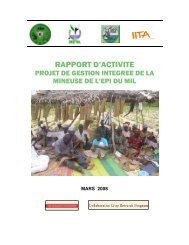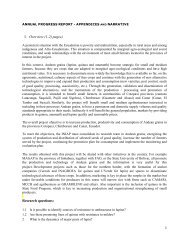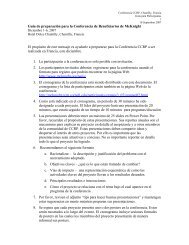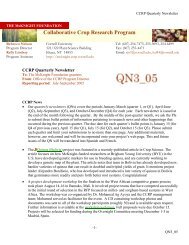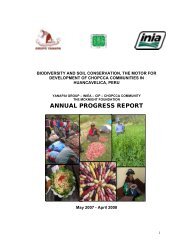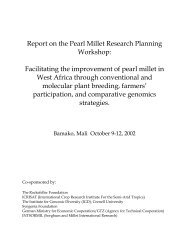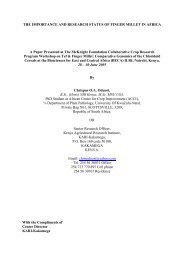English - McKnight Foundation Collaborative Crop Research Program
English - McKnight Foundation Collaborative Crop Research Program
English - McKnight Foundation Collaborative Crop Research Program
Create successful ePaper yourself
Turn your PDF publications into a flip-book with our unique Google optimized e-Paper software.
<strong>McKnight</strong> <strong>Foundation</strong> <strong>Collaborative</strong> <strong>Crop</strong>s <strong>Research</strong> Project No: 06-741<br />
Development and promotion of Alectra resistant cowpea cultivars for<br />
smallholder farmers in Malawi and Tanzania<br />
Conclusion<br />
Cowpea grain and leaves are widely consumed in the two surveyed areas. The<br />
contribution of micro and macro nutrients is significant for both developed lines and local<br />
varieties but with leaves having greater mineral content than grain. Therefore awarenessraising<br />
within communities to consume more cowpea leaves is required. However the<br />
amount produced per household is low compared to requirements. Consequently cowpea<br />
intake per capita is low, and does not meet the RDA. However, since households in both<br />
areas still have ample land they should be encouraged to increase the area planted as well<br />
as planting higher yielding varieties in conjunction with preferred local varieties. This<br />
does however require further market investigation.<br />
Other important nutrients such as vitamins, amino acid profile and levels of<br />
antinutritional factors (tannins and phytates) should also be further investigated. The<br />
vitamins and amino acids influence in nutrition while the antinutritional factors influence<br />
on the bioavailability of the nutrients in the body.<br />
Acknowlegement<br />
The authors would like to acknowledge the financial assistance from the <strong>McKnight</strong><br />
<strong>Foundation</strong>, who facilitated successful survey and laboratory analysis of macro and<br />
micronutrients.<br />
References<br />
Agazounon, C., Coulibaly, O. and Houndekon, V. (2004) Analysis of of cowpea<br />
processing techniques into ‘atta’ in Benin. Bulletin de la recherché Agronomique<br />
du Benin. No. 46, September 2004.<br />
Ahenkora, K. Adu Dapaah, H. K. and Agyeman, A. (1998) Selected nutritional<br />
components and sensory attributes of cowpea (Vigna unguiculata [L.]Walp)<br />
leaves Plant Foods for Human Nutrition 52: 221–229.<br />
AOAC (1995), Official methods of analysis. Association of Official Analytical Chemists<br />
methods, AOAC 16 th edition Nos. 963.13, 968.08, 970.12, 915.03, 920.87.<br />
Washington, D.C.<br />
Asante, I. K., Adu-Dapaah, H Addison (2006) Seed weight and protein and tannin<br />
contents of 32 cowpea accessions in Ghana. Journal of Tropical Science, 44<br />
(2): 77 – 79.<br />
Barret R. P. (1990) Legume species as leafy vegetables. In: Janick J, Simon J. E. (eds),<br />
Advances in new crops. Portland, OR: Timber Press, pp 391–396.<br />
Horax, R., Hettiarachchy, N. S., and Jalaluddin M. (2004).Preparation, characterization<br />
and functional properties of protein isolate from cowpea (Vigna unguiculata L.<br />
Walp.) Dept. of Food Science, Univ. of Arkansas, 2650 N. Young Avenue,<br />
Fayetteville, AR AR 72704, (2) Department of Agriculture, University of<br />
Arkansas, Pine Bluff, AR 71611.<br />
http://ift.confex.com/ift/2004/techprogram/paper_22759.htm.Accessed<br />
19.09.2009.



